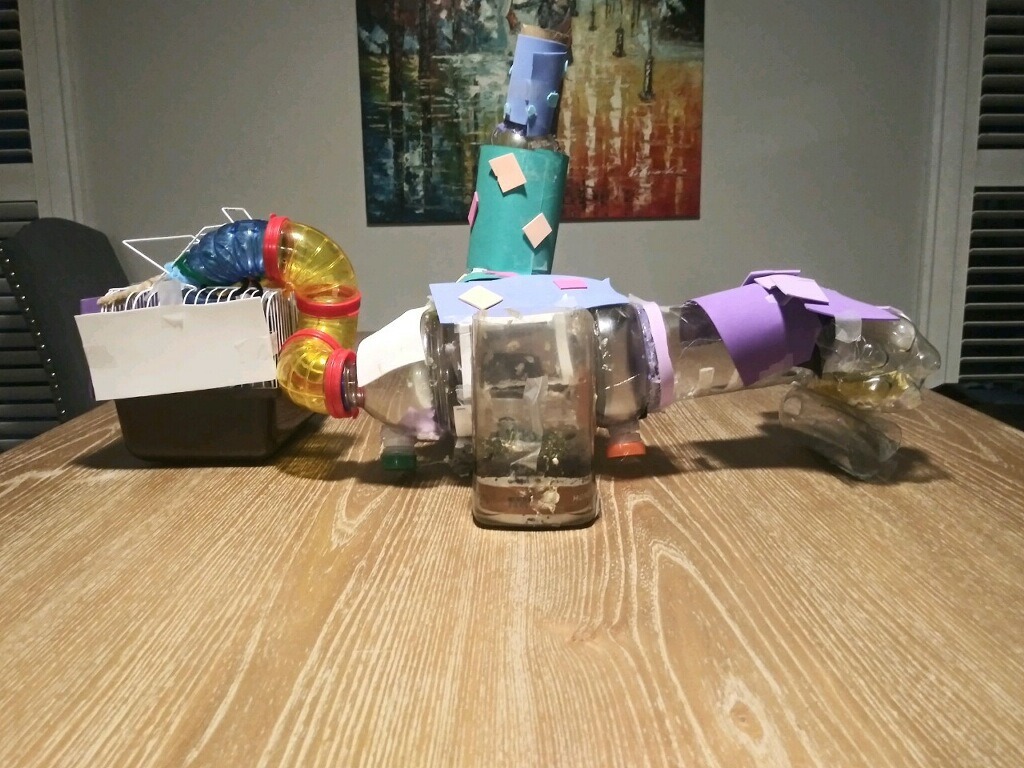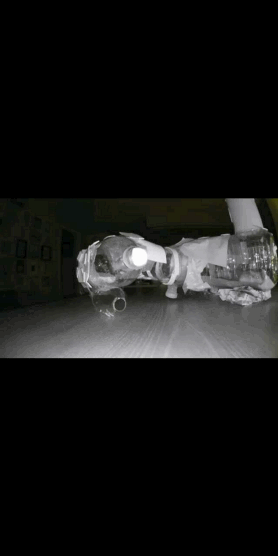Robo-Hamster Cottage
Event Location: Cocoa-FL
Competition: Critter Comfort Cottage
Division: 6-8
School: Carwise Middle
Team Size: 4
TEAM NAME: Mecha hamsters
SCHOOL NAME: Joseph L. Carwise Middle
Featured Photo:

The objective of this STEM project is to design and build a comfortable living space for some sort of critter.
Critter chosen: Roborovskiy hamster

Roborovskiy hamsters info
size: about 2 inches long
color: sand colored with white markings above their eyes
habitat: desert regions
originated from: central Asia
preferred humidity: 40%60%
preferred temperature: 75°-85°F
diet: grains, vegetables, fruit, plants, and insects (in small quantities)
breathing rate: 34-114 bpm
pulse: 250-500 bpm
weight: 0.71 – 0.88 oz.
Features:
- Clover room: hamsters can enjoy fresh food straight from their garden
- Sand room: As a hamster’s natural habitat is the desert, they will enjoy a room where they can burrow and clean themselves in the sand
- Additional space: hamsters are very active they will enjoy an extra room where they can climb and run around
- Feeding room: sometimes feeding hamsters can be messy, so we provided a room where there is a tube where the food can drop directly into the bowl.
Materials Used
- Sand
- blue hamster tube
- yellow hamster tube (3)
- Greek Gods Yourt container
- Snapple tea container
- Acai drink container
- hot glue
- pipe cleaners (10)
- hamster bottle
- orange folder
- small brown hamster wheel
- pineapple chalk
- assorted hamster food
- soil
- clover seeds
- tape
- hamster plate
- brown plastic container bottom
- metal wire top of cage
- assorted bottle caps (5)
- non-toxic foam spray
- cardboard
- sparkling ice water bottle
- black costruction paper
- 2 bottles (about 20 oz)
- newspapers
- duct tape
Recycled Parts
- blue hamster tube
- yellow hamster tube (3)
- Greek Gods Yougrt container
- Snapple tea container
- Acai drink container
- hamster bottle
- orange folder
- small brown hamster wheel
- pineapple chalk
- soil
- brown plastic container bottom
- assorted bottle caps (5)
- cardboard
- sparkling ice water bottle
- 2 bottles (about 20 oz)
- newspapers
Bought Parts
- clover seeds
- non-toxic foam spray
Building Process
- 1st step taken: connect brown plastic container bottom to metal wire top of cage
- 2nd step taken: put blue tube into opening in metal wire top of cage
- 3rd step taken: secure blue tube with pipe cleaners
- 4th step taken: cover up the remaining opening in cage with pipe cleaners and piece of orange folder
- 5th step taken: cut up folder and put the strips of folder around the cage for darkness in the cage
- 6th step taken: connect yellow tubes to the blue tube
- 7th step taken: cut top of acai bottle
- 8th step taken: cut a rectangular hole in acai and Snapple bottle
- 9th step taken: cut of top of acai bottle
- 10th step taken: filter the sand with the siff and use it as bedding
- 11th step taken: hot glue acai bottle and snapple bottle together
- 12th step taken: make sure the bottle structure is stable by hot gluing bottle caps and top of acai bottle on the bottom of the snapple bottle
- 13th step taken: cut bottom part of greek gods yogurt container
- 14th step taken: put pineapple chalk into bottle cage
- 15th step taken: put hamster wheel, bottle and food holder into brown bottom cage
- 16th step taken: grow clover plant
- 17th step taken: put clover plant into bottle cage
- 18th step taken: make crawl space for hamster
- 19th step taken : make feeding room
- 20th step taken: connect all parts together
- 21 step taken: put construction paper on the inside of the enclosure
- 22th step taken: fix major issues
Gallery







Critter Test
During a 9-hour night period, the cottage preformed very well in sustaining the critter. The hamster seemed to enjoy the sand pit, as well as the extra room. Despite being product-fed their whole life, they devoured the clovers set for them. They showed some interest towards the apple and carrot put in the drop pit, but ultimately showed a greater liking to the clover.




Advertisement video:
Insight video:
\
Challenges encountered during building:
- While building we discovered that there were a lot of sharp shells in the sand from clearwater, so we filtered through the sand to make it purer
- another challenge we encountered was in growing the plant because it died couple of times, so we had to start over with growing the plant.
- A final challenge we encountered was that the hamster was able to escape through a hole in the cage which we had to patch up.
intended for indoor use
Team members
Name: Rita B
Grade: 7th
Name: Matias G
Grade: 7th
Name: Mya F
Grade: 6th
Name: Chloe T
Grade: 6th
Resources
https://hamsterhideout.com
https://feedingnature.com
https://hamstercare.com
https://www.hamster.com
https://www.petco.com
https://animals.mom.com
EXACTO knife
Google images
Pexels.com

This is very detailed! The use of the ring camera is a great idea! Very well done!